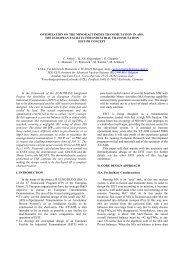AnsaldoEnergia
AnsaldoEnergia - KIT
AnsaldoEnergia - KIT
- No tags were found...
You also want an ePaper? Increase the reach of your titles
YUMPU automatically turns print PDFs into web optimized ePapers that Google loves.
Divisione Nucleare<br />
Progetto<br />
Project<br />
PDS-XADS<br />
<strong>AnsaldoEnergia</strong><br />
Identificativo<br />
Document no.<br />
XADS 20 TRIX 009<br />
Rev.<br />
Rev.<br />
1<br />
Cl. ris.<br />
class<br />
Pagina<br />
Page<br />
23<br />
The Argon is pumped to the Reactor Vessel through a 2" header that is routed to the<br />
Primary System. Downstream of the two Reactor Coolant Boundary isolation valves, the<br />
piping turns into a circular header which parcels out into 24, ½" OD tubes, symmetrically<br />
arranged around a circumferential configuration, to be directed to various sectors of the<br />
Primary System. Each of these tubes is provided with a manual flow control valve, to<br />
equalize the gas flowrate through the various pipes. After penetrating the Reactor Roof, the<br />
tubes deeply plunge into the primary coolant at the Riser Channels level, and end up with a<br />
gas sparger, located 500 mm above the top of Core region, and shaped so that the outlet of<br />
the gas stream is directed upwards.<br />
Scope of the Argon injection is to enhance circulation of the primary coolant, based on the<br />
creation of a differential floating force between the primary coolant in the gas injection<br />
region and the upper region. The gas, after exiting the distribution spargers, is fractionated<br />
into a myriad of small bubbles. The resulting effect is one of swelling of the primary coolant<br />
volume, so that the apparent density of the Lead-Bismuth eutectic lowers, and the primary<br />
coolant is pushed upwards, creating an empty space which is immediately occupied by the<br />
coolant from the Core. After accomplishing its mission, the Argon is delivered to the cover<br />
gas space above the liquid metal surface.<br />
From the above-mentioned circumferential header, another ½” OD tube provides a small<br />
gas flow rate to the integrated purification unit (approximately 1 liter per second at normal<br />
conditions) to develop a driving force to overcome the pressure loss through the filter unit,<br />
allowing it to work.<br />
At the compressors outlet the excess gas line is used to temporarily store a portion of the<br />
cover gas, should the cover gas space pressure exceed the control band high (+ 50 mbar).<br />
The flow to/from the Buffer Vessel is dictated by two on-off valves (one respectively),<br />
located on the compressor discharge line. The Gas Buffer Vessel also serves to supply an<br />
extra-pressure at the system start-up, to overcome the primary coolant hold-up contained in<br />
the gas injection pipes, and to allow gas decay prior to routing the gas to the Waste Gas<br />
System (WGS).<br />
Downstream of the compressors there is a Hydrogen/Steam and Oxygen Injection Unit<br />
which is periodically operated to adjust the concentration of Oxygen in the cover gas.<br />
All system components are shielded against the radiation coming from the cover gas. All<br />
effluents, gaseous and liquid, are routed to the waste systems for storage and reprocessing.<br />
The circuit is accurately sealed to avoid external air to enter the sections under vacuum,<br />
and gas to be released to the environment in the pressurized portion.<br />
3.2.6 Secondary Coolant System<br />
The Secondary Coolant System (SCS) (see Figure 3.2-9) basically consists of two<br />
independent identical subsystems (main loops), each one feeding a couple of IHXs and<br />
DNU 020/1





